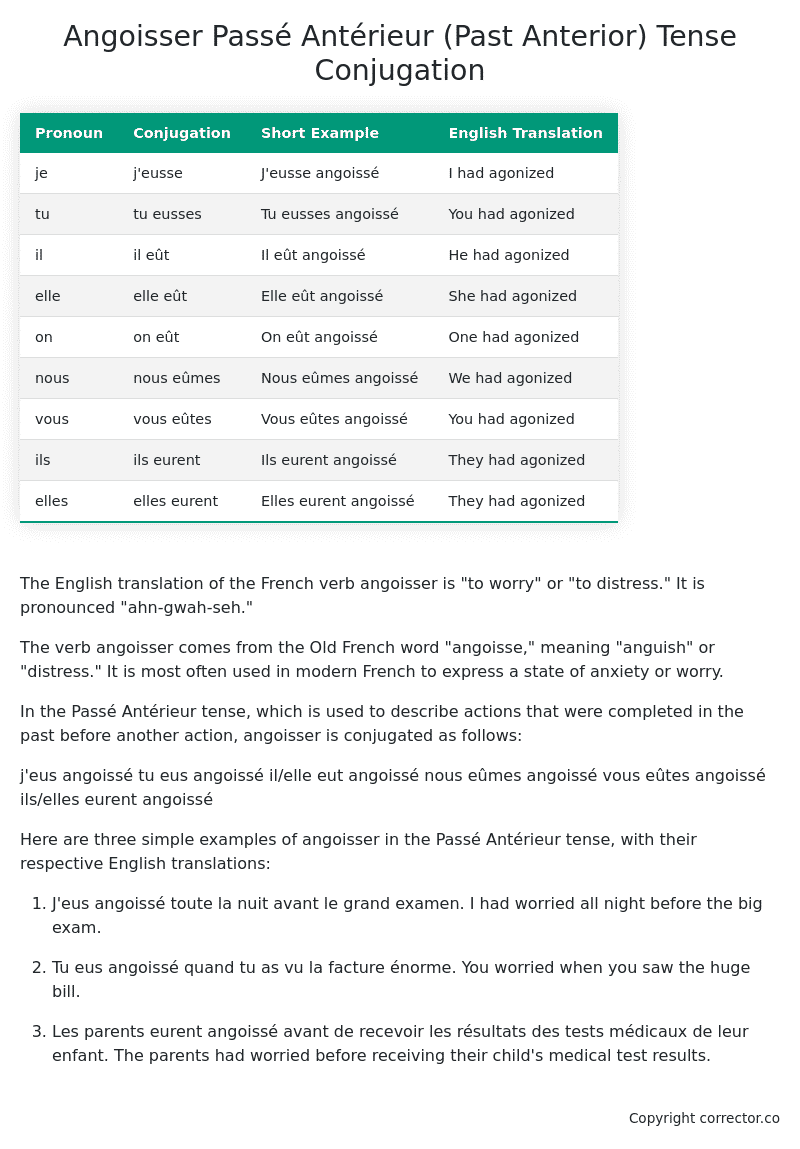Passé Antérieur (Past Anterior) Tense Conjugation of the French Verb angoisser
Introduction to the verb angoisser
The English translation of the French verb angoisser is “to worry” or “to distress.” It is pronounced “ahn-gwah-seh.”
The verb angoisser comes from the Old French word “angoisse,” meaning “anguish” or “distress.” It is most often used in modern French to express a state of anxiety or worry.
In the Passé Antérieur tense, which is used to describe actions that were completed in the past before another action, angoisser is conjugated as follows:
j’eus angoissé
tu eus angoissé
il/elle eut angoissé
nous eûmes angoissé
vous eûtes angoissé
ils/elles eurent angoissé
Here are three simple examples of angoisser in the Passé Antérieur tense, with their respective English translations:
-
J’eus angoissé toute la nuit avant le grand examen.
I had worried all night before the big exam. -
Tu eus angoissé quand tu as vu la facture énorme.
You worried when you saw the huge bill. -
Les parents eurent angoissé avant de recevoir les résultats des tests médicaux de leur enfant.
The parents had worried before receiving their child’s medical test results.
Table of the Passé Antérieur (Past Anterior) Tense Conjugation of angoisser
| Pronoun | Conjugation | Short Example | English Translation |
|---|---|---|---|
| je | j’eusse | J’eusse angoissé | I had agonized |
| tu | tu eusses | Tu eusses angoissé | You had agonized |
| il | il eût | Il eût angoissé | He had agonized |
| elle | elle eût | Elle eût angoissé | She had agonized |
| on | on eût | On eût angoissé | One had agonized |
| nous | nous eûmes | Nous eûmes angoissé | We had agonized |
| vous | vous eûtes | Vous eûtes angoissé | You had agonized |
| ils | ils eurent | Ils eurent angoissé | They had agonized |
| elles | elles eurent | Elles eurent angoissé | They had agonized |
Other Conjugations for Angoisser.
Le Present (Present Tense) Conjugation of the French Verb angoisser
Imparfait (Imperfect) Tense Conjugation of the French Verb angoisser
Passé Simple (Simple Past) Tense Conjugation of the French Verb angoisser
Passé Composé (Present Perfect) Tense Conjugation of the French Verb angoisser
Futur Simple (Simple Future) Tense Conjugation of the French Verb angoisser
Futur Proche (Near Future) Tense Conjugation of the French Verb angoisser
Plus-que-parfait (Pluperfect) Tense Conjugation of the French Verb angoisser
Passé Antérieur (Past Anterior) Tense Conjugation of the French Verb angoisser (this article)
Futur Antérieur (Future Anterior) Tense Conjugation of the French Verb angoisser
Subjonctif Présent (Subjunctive Present) Tense Conjugation of the French Verb angoisser
Subjonctif Passé (Subjunctive Past) Tense Conjugation of the French Verb angoisser
Subjonctif Imparfait (Subjunctive Imperfect) Tense Conjugation of the French Verb angoisser
Subjonctif Plus-que-parfait (Subjunctive Pluperfect) Tense Conjugation of the French Verb angoisser
Conditionnel Présent (Conditional Present) Tense Conjugation of the French Verb angoisser
Conditionnel Passé (Conditional Past) Tense Conjugation of the French Verb angoisser
L’impératif Présent (Imperative Present) Tense Conjugation of the French Verb angoisser
L’infinitif Présent (Infinitive Present) Tense Conjugation of the French Verb angoisser
Struggling with French verbs or the language in general? Why not use our free French Grammar Checker – no registration required!
Get a FREE Download Study Sheet of this Conjugation 🔥
Simply right click the image below, click “save image” and get your free reference for the angoisser Passé Antérieur tense conjugation!

Angoisser – About the French Passé Antérieur (Past Anterior) Tense
Formation of the Passé Antérieur
Common Usage Patterns
Literature
Historical Texts
Formal Writing
Interactions with Other Tenses
Passé Composé (Present Perfect)
Imparfait (Imperfect)
Futur Antérieur (Future Perfect)
Summary
I hope you enjoyed this article on the verb angoisser. Still in a learning mood? Check out another TOTALLY random French verb conjugation!


